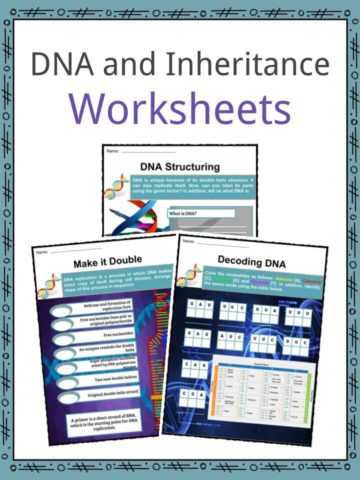Download This Sample
This sample is exclusively for KidsKonnect members!
To download this worksheet, click the button below to signup for free (it only takes a minute) and you'll be brought right back to this page to start the download!
Sign Me Up
Table of Contents
James Dewey Watson is an American geneticist, biophysicist, and molecular biologist who played an important role in discovering the molecular structure of DNA. This substance is responsible for the traits of an individual and the inheritance of genes. He focused his research on molecular biology and genetics, aiming to advance his understanding of diseases.
See the fact file below for more information on James Watson or you can download our 27-page James Watson worksheet pack to utilize within the classroom or home environment.
Key Facts & Information
EARLY LIFE
- James Dewey Watson was born on April 6, 1928, and raised in Chicago, Illinois. He is the only son of James Watson, of English descent, and Jean Mitchell. He grew up in a Catholic environment but later described himself as “an escapee from the Catholic religion.”
- His father was fascinated by birdwatching, and young James Dewey was interested too. This shared hobby with his father led him to consider a career in ornithology.
- Around 1940, a bright 12-year-old James participated in Quiz Kids, a radio program where the host questioned five intelligent kids, and they got points for answering correctly.
EDUCATION AND CAREER
- Watson started school at a private institution called Horace Mann Grammar School, where he studied for eight years; he then moved to South Shore High School for a further two years.
- At 15, the intellectually gifted Watson received a scholarship to the University of Chicago.
- He entered the experimental four-year college through an early admissions program, where students with two years of high school experience were accepted. He enrolled in the summer of 1943 to study Zoology, a choice highly influenced by his father’s fascination with birdwatching, an interest shared by Watson.
- In 1947, Watson graduated from the University of Chicago with a Bachelor of Science degree in Zoology, later changing to a different field of Science.
- In 1946, his interest in ornithology shifted to genetics after reading Erwin Schrödinger’s book about the Science of the human body, entitled What is Life? The Physical Aspect of the Living Cell.
- In 1947, he left the University of Chicago to become a graduate student at the University of Indiana. He was inspired by the geneticist Hermann Joseph Muller who is best known for receiving a Nobel Prize in 1946 for his work in radiation genetics. During his time in Indiana, the American biologist Tracy Morton Sonneborn, best known for his work in paramecium, greatly inspired Watson.
- Watson’s education in Indiana was also deeply influenced by the Italian microbiologist Salvador Luria who was his doctoral advisor.
- Under Luria’s supervision, Watson’s Ph.D. thesis was the study of bacteriophage multiplication under hard X-ray.
- During his studies at Indiana University, Watson became a member of the Phage Group as a working scientist. His involvement in the intellectual group contributed to his desire to further study the structure of Deoxyribonucleic Acid (DNA).
- In September 1950, Watson went to Copenhagen University for his postdoctoral research and as a member of the National Research Council. Watson conducted experiments revolving around the bacteriophages and viruses that can infect bacteria.
- He used radioactive phosphate as a marker to determine which component of the bacteriophage could be passed on to the target bacteria during viral infection. Watson’s goal was to determine whether DNA or protein was the genetic material, but upon consulting with microbiologist Max Delbruck, the results determined were ambiguous.
- It was in 1951 that Watson gained certainty about the structure of the DNA after attending a conference in Italy where he saw Maurice Wilkins discuss the DNA molecule using X-ray diffraction data.
ACHIEVEMENTS
- Watson was determined to identify the structure of the DNA as it was clear to him that it was the key to understanding life. In October 1951, he started to work in Cavendish Laboratory at the University of Cambridge, together with the English molecular biologist Francis Crick.
- In March 1953, Watson and Crick successfully inferred the structure of DNA. Watson realized that the molecule was made up of four organic bases arranged in pairs. They also discovered that the organic bases were linked in repeated patterns of phosphate and sugar backbone.
- The subsequent information led to the discovery of the DNA structure, which consists of two strands of molecules twisted together to form a double helix.
- Watson and Crick created a 3-dimensional model of the molecule that also showed how the individual strands could duplicate themselves.
- Upon the discovery of the DNA structure, the director of the Cavendish Laboratory, Sir Lawrence Bragg, announced the discovery at the Solvay conference, but it went unnoticed by the reporters.
- Watson and Crick then submitted a paper on April 25, 1953, entitled “Molecular Structure of Nucleic Acids: A Structure for Deoxyribonucleic Acid” to the scientific journal Nature.
- Bragg held another talk in London about Watson and Crick’s experiment which finally gained the attention of the journalist Ritchie Calder. Carter published an article in the London newspaper entitled “Why You are You. Nearer Secret of Life”. Various scientists then went to see the model and were amazed by the accuracy of the discovery.
- The discovery of the DNA structure is crucial as it was the turning point in the advancement of Science, specifically in molecular biology and genetics. Maurice Wilkins, James Watson, and Francis Crick were awarded the Nobel Prize in Physiology for their work in nucleic acids.
- In 1968, Watson married Elizabeth Lewis and had two sons.
CONTROVERSIES
- Despite their success in discovering the DNA model, Watson and Crick faced criticism, as they unauthorizedly used the famous Photo 51, a DNA diffraction image taken by Rosalind Franklin and her student Raymond Gosling. They also used some of her unpublished data without her consent when creating the DNA model. Franklin was also the one who told Watson that the backbone should be placed on the outside.
- Watson and Crick’s initial models showed the backbone chains on the inside, with organic bases pointing outwards.
- It was later revealed that they obtained Franklin’s data with the help of Maurice Wilkins, who showed her findings to Watson when he visited King’s College in 1953 without her knowledge.
James Watson Worksheets
This is a fantastic bundle that includes everything you need to know about James Watson across 27 in-depth pages. These are ready-to-use worksheets that are perfect for teaching kids about James Watson, who is an American geneticist, biophysicist, and molecular biologist who played an important role in discovering the molecular structure of DNA.






Complete List of Included Worksheets
Below is a list of all the worksheets included in this document.
- James Watson Facts
- Board of Life
- James Biography
- What Happened?
- James and I
- The Team
- What is it?
- Your Stand
- Watch you learning?
- Is it a Fact?
- If I am a Scientist
Frequently Asked Questions
What is James Watson best known for?
Watson won the Nobel Prize for Medicine in 1962 with Francis Crick and Maurice Wilkins. They won for their work on the structure of DNA. Their work was based on Rosalind Franklin’s data. Watson then wrote a book called The Double Helix: A Personal Account of the Discovery of the Structure of DNA in 1968.
How did James Watson change the world?
From 1988 to 1992, James Watson was the first Director of the Human Genome Project at the National Institutes of Health. The Human Genome Project was a task to decode humankind’s entire genetic code. This groundbreaking feat has provided insight into our species’ biological markers ever since!
What did James Watson discover?
In 1953, James Watson made a monumental scientific discovery that changed history: they uncovered the double helix of deoxyribonucleic acid, DNA for short, opening up an entirely new realm of molecular biology.
Link/cite this page
If you reference any of the content on this page on your own website, please use the code below to cite this page as the original source.
Link will appear as James Watson Facts & Worksheets: https://kidskonnect.com - KidsKonnect, December 8, 2022
Use With Any Curriculum
These worksheets have been specifically designed for use with any international curriculum. You can use these worksheets as-is, or edit them using Google Slides to make them more specific to your own student ability levels and curriculum standards.



